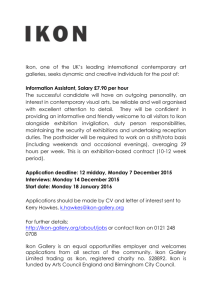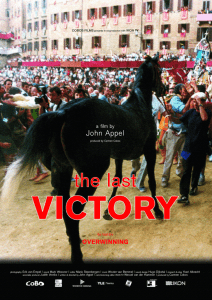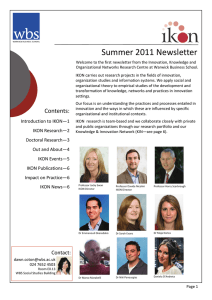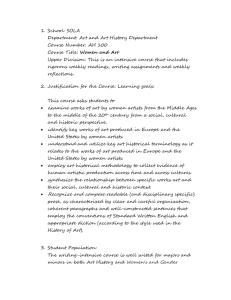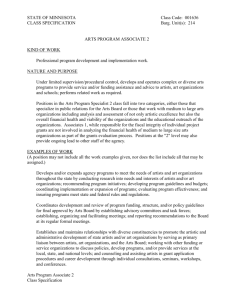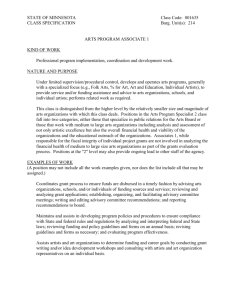A short history of Ikon
advertisement
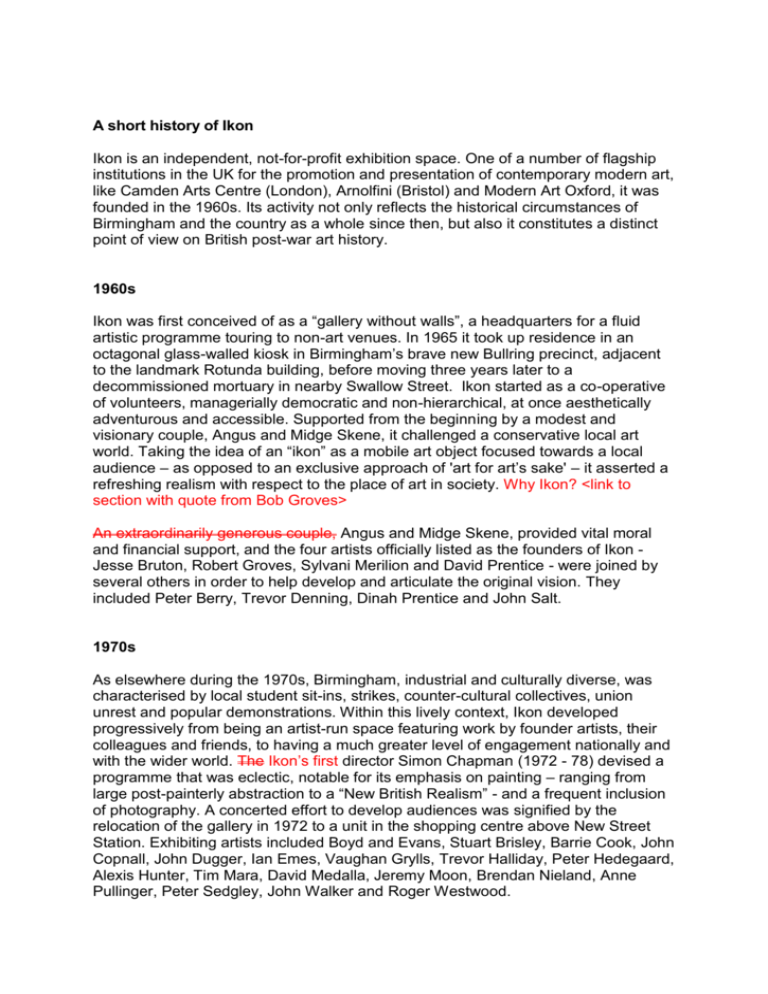
A short history of Ikon Ikon is an independent, not-for-profit exhibition space. One of a number of flagship institutions in the UK for the promotion and presentation of contemporary modern art, like Camden Arts Centre (London), Arnolfini (Bristol) and Modern Art Oxford, it was founded in the 1960s. Its activity not only reflects the historical circumstances of Birmingham and the country as a whole since then, but also it constitutes a distinct point of view on British post-war art history. 1960s Ikon was first conceived of as a “gallery without walls”, a headquarters for a fluid artistic programme touring to non-art venues. In 1965 it took up residence in an octagonal glass-walled kiosk in Birmingham’s brave new Bullring precinct, adjacent to the landmark Rotunda building, before moving three years later to a decommissioned mortuary in nearby Swallow Street. Ikon started as a co-operative of volunteers, managerially democratic and non-hierarchical, at once aesthetically adventurous and accessible. Supported from the beginning by a modest and visionary couple, Angus and Midge Skene, it challenged a conservative local art world. Taking the idea of an “ikon” as a mobile art object focused towards a local audience – as opposed to an exclusive approach of 'art for art’s sake' – it asserted a refreshing realism with respect to the place of art in society. Why Ikon? <link to section with quote from Bob Groves> An extraordinarily generous couple, Angus and Midge Skene, provided vital moral and financial support, and the four artists officially listed as the founders of Ikon Jesse Bruton, Robert Groves, Sylvani Merilion and David Prentice - were joined by several others in order to help develop and articulate the original vision. They included Peter Berry, Trevor Denning, Dinah Prentice and John Salt. 1970s As elsewhere during the 1970s, Birmingham, industrial and culturally diverse, was characterised by local student sit-ins, strikes, counter-cultural collectives, union unrest and popular demonstrations. Within this lively context, Ikon developed progressively from being an artist-run space featuring work by founder artists, their colleagues and friends, to having a much greater level of engagement nationally and with the wider world. The Ikon’s first director Simon Chapman (1972 - 78) devised a programme that was eclectic, notable for its emphasis on painting – ranging from large post-painterly abstraction to a “New British Realism” - and a frequent inclusion of photography. A concerted effort to develop audiences was signified by the relocation of the gallery in 1972 to a unit in the shopping centre above New Street Station. Exhibiting artists included Boyd and Evans, Stuart Brisley, Barrie Cook, John Copnall, John Dugger, Ian Emes, Vaughan Grylls, Trevor Halliday, Peter Hedegaard, Alexis Hunter, Tim Mara, David Medalla, Jeremy Moon, Brendan Nieland, Anne Pullinger, Peter Sedgley, John Walker and Roger Westwood. In late 1978, Ikon moved to new premises in John Bright Street. Jonathan – in this section should we mention the IRA bomb? 1980s Above all, the 1980s ushered in Postmodernism to make a decisive break in the conventionally linear narrative of artistic development. Then, arising out of postpainterly, conceptual impulses that characterised preceding years, there were lively discourses around post-feminism, post-structuralism and post-colonialism, manifested through a plethora of styles and media that in turn conveyed an attitude of “anything goes”. There was the famous return to painting (figurative painting especially and painterly), a shameless appropriationism that saw a ‘pick and mix’ from art history, non-western art and popular culture, an enthusiastic re-embrace of Dada and the challenge to notions of self-contained works of art through the increasing popularity of installation. In Britain, particularly, Postmodernism was a fast-moving zeitgeist that chimed in with broader cultural shifts, in particular the politics that evolved under the premiership of Margaret Thatcher. Ikon’s programme during this decade, under the directorships of Hugh Stoddart (1978 - 81) and Antonia Payne (1981 - 88), must be considered in this context. Exhibiting artists included Rasheed Araeen, Gillian Ayres, Stuart Brisley, Helen Chadwick, Hannah Collins, Jochen Gerz, Paul Graham, Susan Hiller, Bert Irvine, Alan Miller, Pieter Laurens Mol, Dennis Oppenheim, Cornelia Parker and Sean Scully. 1990s Under the directorship of Elizabeth MacGregor (1989 – 1999) Ikon developed its reputation as a venue primarily for new and innovative work by living artists involving a range of media: painting, sculpture, video, installation and photography. The programme included numerous exhibitions from abroad, giving local audiences more insight into the international contexts with which British art, especially due to the rise of the Young British Artists (YBAs), was becoming increasingly engaged. At the same time there was a community touring programme for community centres, schools, hospitals, libraries and smaller galleries and museums throughout the West Midlands, concomitant concurrent with an increased emphasis on art education. Such organisational reform strengthened Ikon’s case for its most recent move into the refurbished Oozells Street School building, Brindleyplace <link to Brindleyplace page>, in early 1998. Artists exhibiting during the 1990s included Cecile Bart, Fiona Banner, Sylvie Blocher, Dorothy Cross, Dalziel + Scullion, Juan Davila, Diller and Scofidio, Mark Dion, Permindar Kaur, Rose Finn Kelcey, Antony Gormley, Victor Grippo, Lisa Milroy, Avis Newman, Donald Rodney, Eva Rothschild, Terry Shave, Yinka Shonibare, Amikam Toren and Mark Wallinger. 2000 – Since its arrival in Brindleyplace Ikon has become more outgoing, more internationalist than ever before, whilst at the same time being locally engaged and more committed to its role as a producer. Our off-site programme, including projects located in the public realm, touring and collaborations (including international biennials) and educational outreach, is crucial to Ikon’s identity, signifying a conviction that artistic experience is not the goal of some pseudo-religious pilgrimage. Ikon’s current Director Jonathan Watkins (1999- ) has ensured that Ikon continues to , as ever, asserts a dynamic relationship with art, aspiring as much to accessibility as it does to excellence. In 1964, the artists’ group that founded Ikon published a prospectus that was as clear as it was idealistic. Their aesthetic proposition was neatly summarised: Ikon is intended as an antithesis to exclusive art establishments and galleries … [it] has been formed because of the need for an accessible place where the exchange of visual ideas can become a familiar reality. As in the early years, Ikon’s current artistic programme features solo projects, offering opportunities for more in-depth consideration of each artist’s work whilst giving rise to telling juxtapositions. Unconvinced by the distinction often made between “artist-led” and “audience-led” programmes, Ikon prefers the idea of its activity overall being “Ikon-led”, proactive in response to a global art conversation and engaged in all aspects of cultural life, within and beyond the institution of high art. Artists exhibited at Ikon since 2000 include Ignasi Aballi, Adel Abdeemsmed, Giovanni Anselmo, Christiane Baumgartner, Frederic Bruly Bouabré, Alice Cattaneo, Ruth Claxton, Martin Creed, David Cunningham, Marjolijn Dijkman, Ceal Floyer, Katherina Grosse, Arturo Herrera, Sofia Hulten, June Bum Park, On Kawara, Vladimir Logutov, Mike Marshall, Juneau Projects, On Kawara, Kelly Mark, Julian Opie, Cornelia Parker, Simon Patterson, Cesare Pietrojusti, Navin Rawanchaikul, Beat Streuli, Tadasu Takemine, Zhao Bandi and Andrea Zittel. Jonathan – would be good to get a lead on which images we should use to represent each decade – we could have a selection but perhaps only 4?
